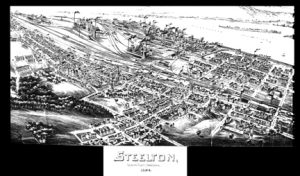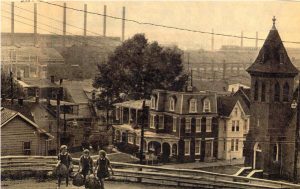My purpose in creating this webpage is to present the town of Steelton in a historical, geographical, and environmental perspective. It focuses on the Susquehanna River and its floods, the steel mill, public works, and the section of town known as the West Side. Enjoy your time here!
Created by Eric J. Wiediger
Dickinson College American Mosaic 2001

A sketch of Steelton, Pennsylvania, in 1894
Photograph from Stop, Look, Listen: Steelton: Pennsylvania
On January 26, 1880, the Borough of Steelton officially became a town. By this time, the majority of the land had already been occupied by the new Pennsylvania Steel Company for more than ten years, and seventy-five residents’ homes surrounded the facility. As the steel plant quickly expanded, more houses, stores, and churches were built. Families from around the world came in search of work. A census from 1898 listed thirty-three nationalities residing in Steelton (Drawburgh 1930). At Steelton’s population peak in 1910, there were 14,246 residents — 6,000 working in the mill. In 1984, only 6,400 residents lived in the entire town (Echenbarger 1984). Since the mill was the main employer in town, many had left to look for work elsewhere after most sections of the mill closed in the 1970’s and 1980’s. Other residents were forced from their homes when the West Side was demolished after the 1972 Flood and the subsequent sale of the area to Bethlehem Steel Company.
Today, Steelton pride is still quite alive. According to the 1990 US Census Data, there are 5,152 residents within 1,386 families in the Borough of Steelton. Many of the twenty-seven bars still attract customers and the seventeen churches and two schools are still flourishing. With much support from Mayor George Hartwick III, the residents hope to further revive the town. One of the main factors for keeping Steelton alive is its high school sports. The pride in which the town holds for its nationally-ranked teams is astounding.
“I think Steelton, with its sports programs and things like that, keeps a lot of youth in the community. I think we’ll be here for a while.”
— Joe Conjar, a Steelton police officer

Sports are an important part of Steelton
(Echenbarger 1984)
“I love Steelton. It’s my heart. It’s where I want to stay for the rest of my life.” — Keith Travenstein, resident of Steelton